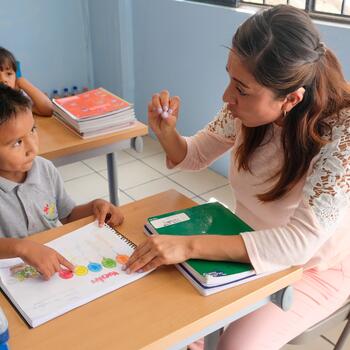By Catherine Jacques - January 18, 2023
In February 2021, we wrote about the “new normal” in education and what shifts we might expect to see coming out of the pandemic. We predicted that in the 2021-22 school year we might see more flexibility in teaching and learning approaches, efforts to combat learning loss, and strategies to address teacher shortages. We also predicted a continued focus on equity and collaboration. To some extent, we have seen these efforts continue in 2022-23.
Many schools have continued using the technology they adopted during the pandemic, which has led to more personalized learning teaching approaches mixed with traditional instruction. The many schools that adopted learning management systems during the pandemic have often found that these systems have many benefits beyond just supporting virtual learning, such as convenient access to information on grades and assignments for students and parents alike. Even teachers who had negative experiences with the fast-tracked adoption of learning management systems in 2020 now see ways they can make teaching easier or more streamlined.
For example, teachers can give feedback and student assignments and log grades in one central platform, which can reduce the amount of time teachers spend on grading. Having one central place with information on student assignments and grades can also help streamline communication with families by making information on student grades transparent and on-demand.
Efforts to address teacher shortages have also persisted over the last two years, although states and districts continue to face staffing challenges nationwide. There have been widespread efforts to strengthen the teacher workforce using strategies such as offering signing bonuses and establishing local teacher pipelines (e.g., “grow your own” programs), yet burnout, aggression, politics, and other issues have continued to negatively affect teacher morale and the overall teacher workforce. It’s unlikely that there is a “one-size fits all” solution to teacher shortages.
To effectively address teacher shortages, states and districts likely need multi-faceted strategies (involving multiple different stakeholder groups) that can be customized for different local contexts. There have also been calls for teachers to have more autonomy and creativity in their teaching practices to increase teachers’ job satisfaction and promote retention. Flexibility and autonomy for teachers may become a greater priority over time as states and districts work to find effective ways to address teacher shortages.
Social-emotional learning and mental health supports have certainly become more of a priority in recent years, as educators have seen increases in behavioral issues (including apathy and disengagement) and long-term effects on students’ maturity, mental health, and coping abilities since the pandemic. Today, many teachers report that they see social-emotional skills as equally or more important than academics. We know that suspensions don’t work, yet alternative ways to help students with disruptive behaviors or significant social-emotional needs (such as restorative justice and comprehensive wraparound services, including mental health supports) are often beyond schools’ current capacity. Social-emotional learning supports are also related to equity, as social-emotional challenges may exacerbate achievement gaps, particularly for older students. Finding sustainable and effective ways to support students’ social-emotional learning and effectively manage behavioral incidences are likely to be continued priorities for many educators in the near future.
So what will be our “new normal” going forward?
While we can’t predict the future, it seems likely that schools will continue to grapple with finding solutions to common problems such as teacher shortages and student learning loss. Finding ways to effectively address social-emotional learning in particular may remain a top priority for educators and education leaders in 2023, as some see social-emotional learning challenges as a root cause of other systemic challenges. In particular, we might expect to see more investment in supporting students’ mental health through training for existing staff and hiring additional support staff. On a positive note, we may also see more personalized and flexible teaching and learning approaches as schools that have continued or strengthened these efforts post-pandemic share their success stories and best practices. We might see more use of technology to support personalized learning, which beyond the use of learning management systems might also include innovations like gamification to boost student engagement. Relatedly, we may see continued investment in K-12 education in computer science and other STEM fields through career and technical education. We may also see more student voice and autonomy as educators explore new ways to engage students in their learning and address non-disruptive behavioral issues (e.g., apathy) through personalized learning approaches. This might include giving students more input into daily class activities or assignments. Finally, we might see shifts in how learning is organized to include both more long-term projects as well as more “micro-assignments” that can be completed rapidly.
States and districts that wish to leverage evidence-based practices or identify success stories in their own local schools can access resources through the Comprehensive Center Network, including Region 9. Please subscribe to our monthly newsletter and follow @region9cc on Twitter to learn more about emerging priorities and real-life strategies for addressing educational challenges.
Catherine Jacques leads the Region 9 Comprehensive Center’s comprehensive school improvement project with the Iowa Department of Education and is a senior researcher at the American Institutes for Research. She also leads teacher leadership work with the Center on Great Teachers and Leaders. Ms. Jacques has more than a decade of experience studying educator development and school improvement at the local, state, and national levels.
Photo by Ronald Felton on Unsplash
